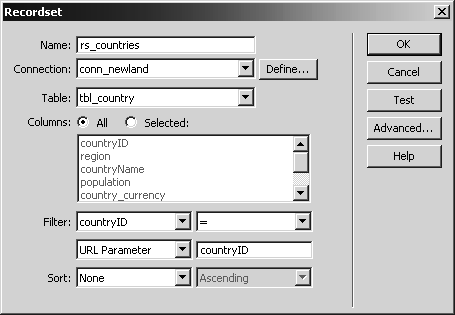Preparing the Output Page
The input page is ready, but it points to a page that doesn't yet exist. You'll fix that in this step. You'll also create a recordset that collects data based on the URL parameter supplied when the user clicks a link on the previous page.
Open generic_template.asp in design view. Enter Newland Tours: Country Profiles as the Title in the toolbar, and save it as profiles_detail.asp.
Once again, our template makes the initial mock-up of a page fast and easy.
Enter Country Profiles: Individual Profiles as the first heading on the page. Then type the following text, each in its own paragraph:
Country Name:
World Region:
Description:
Image Caption:
Population:
Local Currency:
In this and the next few steps, you are building a layout to hold dynamic data.

Click once in Country Name, and select H2 from the Format field of the Property inspector.
The country name should become large and purple, as the CSS style kicks in. You'll format the rest of the fields in the next exercise.
Using the Bindings panel, create a new recordset using the following information:
Name: rs_countries
Connection: conn_newland
Table: tbl_country
Columns: All
Filter: countryID = URL Parameter countryID
Sort: None

You probably know what these settings are going to accomplish, but if you are not sure, click the Test button. Because it is filtering based on a URL parameter, you'll need to provide a test value. Enter 3, and you'll see Taiwan.
When you are finished, the Bindings panel contains the new recordset, which you can use to populate your page.







